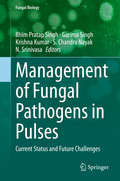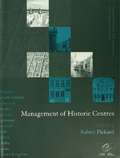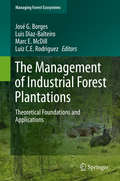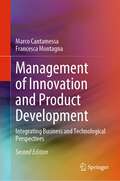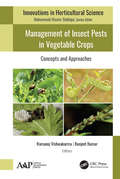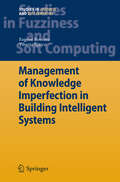- Table View
- List View
Management of Electronic Waste: Resource Recovery, Technology and Regulation
by Anshu PriyaMANAGEMENT OF ELECTRONIC WASTE Holistic view of the current and future trends in electronic waste management, focusing on recycling, technologies, and regulations Management of Electronic Waste delivers a complete overview of all aspects related to the toxicity characterization of electronic wastes, along with other important topics including resource recovery, recycling strategies, biotechnological advancements, and current perspectives on waste generation and management. The book presents hazards associated with conventional recycling methods and highlights environmentally compatible economic approaches for resource recovery, along with eco-friendly strategies for management of electronic wastes. The high metallic content, heterogeneous and composite nature of e-wastes make them a rich secondary reservoir of metals. The book explores the valuable potential of e-waste and highlights the eco-friendly, sustainable technologies and recycling strategies for the profitable and effective conversion of waste to wealth. Written by a highly qualified and internationally renowned author, Management of Electronic Waste covers sample topics such as: Rise of e-waste generation paired with rising economies and mounting demand for electrical and electronic devices, with a country-by-country breakdown Status of e-waste management and recycling efforts around the world, along with key processes that drive e-waste recycling Macroeconomic trends between global demand and supply for metal resources and the transition of linear to circular economy Bioleaching, an economic and green approach for recovery of metals, from e-waste and other low grade metal repositories Different metallurgical approaches for extraction and recovery of resources from e-waste and their pros and cons Filling a gap on the understudied biotechnological recycling techniques and methods for mitigating environmental pollution caused by electronic waste, Management of Electronic Waste serves as an excellent guide on the subject for electronic waste producers, consumers, recycling industries, policy and law makers, academicians, and researchers.
Management of Electronic Waste: Resource Recovery, Technology and Regulation
by Anshu PriyaMANAGEMENT OF ELECTRONIC WASTE Holistic view of the current and future trends in electronic waste management, focusing on recycling, technologies, and regulations Management of Electronic Waste delivers a complete overview of all aspects related to the toxicity characterization of electronic wastes, along with other important topics including resource recovery, recycling strategies, biotechnological advancements, and current perspectives on waste generation and management. The book presents hazards associated with conventional recycling methods and highlights environmentally compatible economic approaches for resource recovery, along with eco-friendly strategies for management of electronic wastes. The high metallic content, heterogeneous and composite nature of e-wastes make them a rich secondary reservoir of metals. The book explores the valuable potential of e-waste and highlights the eco-friendly, sustainable technologies and recycling strategies for the profitable and effective conversion of waste to wealth. Written by a highly qualified and internationally renowned author, Management of Electronic Waste covers sample topics such as: Rise of e-waste generation paired with rising economies and mounting demand for electrical and electronic devices, with a country-by-country breakdown Status of e-waste management and recycling efforts around the world, along with key processes that drive e-waste recycling Macroeconomic trends between global demand and supply for metal resources and the transition of linear to circular economy Bioleaching, an economic and green approach for recovery of metals, from e-waste and other low grade metal repositories Different metallurgical approaches for extraction and recovery of resources from e-waste and their pros and cons Filling a gap on the understudied biotechnological recycling techniques and methods for mitigating environmental pollution caused by electronic waste, Management of Electronic Waste serves as an excellent guide on the subject for electronic waste producers, consumers, recycling industries, policy and law makers, academicians, and researchers.
The Management of Enclosed and Domesticated Deer: International Husbandry Systems and Diseases
by John FletcherThis is the first book devoted to international deer husbandry techniques for the growing industries of venison, velvet antler, and antler trophy production as well as long established extensive park systems for amenity. Written by world leaders in their specialised subjects, chapters shed light on widely differing management systems and the optimum design of deer farms, handling yards and fencing layouts. Moreover, readers will discover the requisites of good stockmanship and specialist veterinarians describe different diseases the deer may develop. Details on available treatments, the general biology of deer and an explanation of controversial ethics of velvet and trophy production complete this work.As deer farming has come of age this collection is timely. At fifty years the New Zealand deer industry carries one million animals with annual venison exports to America, Europe and growing antler markets in China and Korea. Chinese antler production is well-established and Asian reindeer husbandry even more ancient. In North America and Europe, deer are now being kept for antler trophies and amenity in many historic parks. This volume is a valuable resource for everyone researching deer management systems, be it practising veterinarians, deer farmers, park managers or agricultural and veterinary students.
Management of Engineering Projects
by Richard StoneA text relevant to the whole spectrum of engineering which focuses on the administrative, financial and legal aspects of project management. Topics covered include project development and evaluation, management of people, time and budgets and health and safety aspects. Case studies are included.
Management of Food Allergens
by Jacqueline Coutts Richard FielderOne of the greatest challenges facing the food industry is providing safe food to an ever-increasing number of allergic consumers through a global supply chain. Approximately 2–4% of western adults and up to 10% of children are currently thought to be sensitive to food allergens, and the issue is of major commercial significance to food manufacturers. The market for ‘free-from’ foods has grown dramatically in recent years and the demand for gluten- and dairy-free foods shows no sign of abating in the foreseeable future. This volume provides an overview of the safe management of food allergens, aiming to help all those with a vested interest in understanding how to protect consumer health through good manufacturing practice and clear labelling advice. It examines the risk management systems and practices being adopted by the food industry to tackle the growing hypersensitivity of consumers to a range of food proteins. The various aspects of the subject are addressed from a range of perspectives including that of researcher, food manufacturer, enforcement officer, clinician and consumer. There will be an emphasis on the scientific analysis of food and environmental samples and their use in verifying in-process controls and finished-product labelling claims. The book is directed at food scientists and technologists based in industry and research, quality assurance personnel, clinicians and public health officials.
Management of Fungal Pathogens in Pulses: Current Status and Future Challenges (Fungal Biology)
by Bhim Pratap Singh Garima Singh Krishna Kumar S. Chandra Nayak N. SrinivasaPulses have played a major role in human diet and are considered a rich source of proteins. But, the major constraints in achieving the yield of pulses are the occurrences of various diseases and pests. Hence, there is a need to understand major fungal pathogens and their management strategies for sustainable agriculture. The major pulse crops in India and other Asian countries are bengal gram, pigeon pea, black gram, green gram, lentil and peas, which are attacked by several pathogens that cause considerable crop damage. Bengal gram is affected mainly by wilt (Fusarium oxysporum f. sp. ciceri), blight (Mycosphaerella pinodes) and rust (Uromyces ciceris-arietini). The main diseases of pigeon pea are wilt (Fusarium oxysporum) and Phytophtora stem blight (Phytophthora drechsleri f. sp. cajani). Powdery mildew (Erysiphe polygoni) and rust (Uromyces vicia-fabae) are the most important diseases affecting the production of pea. This volume offers details like symptoms, distribution, pathogens associated, predisposing factors and epidemiology, sources of resistance and holistic management of diseases with particular reference to those of economic importance. Several minor diseases of lentil, green gram and of black gram are discussed with their detailed and updated information. This volume provides pooled information regarding the management of major fungal phytopathogens affecting pulses.
Management of Global Construction Projects
by David Moore Andrew Price Edward OchiengThe first textbook of its kind, taking a uniquely global approach to project management in construction. Using a wealth of case studies from around the world to explain theory and practice, the authors take a business-oriented, decision-making approach to project management and the challenges it faces in the modern world. The book covers topics highly relevant to the challenges and opportunities currently facing the global construction industry, including managing culturally-diverse and globally dispersed teams, international project finance and global stakeholders in projects.Management of Global Construction Projects is essential reading for both students of construction management and professionals looking to understand construction project management in a truly global context.
Management of Greywater in Developing Countries: Alternative Practices, Treatment and Potential for Reuse and Recycling (Water Science and Technology Library #87)
by Radin Maya Radin Mohamed Adel Ali Al-Gheethi Amir Hashim Mohd KassimThis book reviews the consequences of improper disposal of greywater into the environment and the most appropriate treatment technologies for developing countries, focusing on the potential to reuse greywater as a production medium for biomass and bio-products. It also describes the quantities and qualitative characteristics, as well as the common practice of discharging greywater in developing countries, and highlights the associated health risks. Further, it compares the management of greywater in developed and developing countries and explores the advantages and disadvantages of various treatment technologies, discussing the reuse of greywater for irrigation purposes in arid and sub-arid countries, especially in the Middle East. The book shows the benefits of greywater and introduces low-cost technologies based on the available local facilities can be used to discharge, reuse, and recycle it.
Management of Hazardous Energy: Deactivation, De-Energization, Isolation, and Lockout
by Thomas Neil McManusHazardous energy present in systems, machines, and equipment has injured, maimed, and killed many workers. One serious injury can stop the growth of your business in its tracks. Management of Hazardous Energy: Deactivation, De-Energization, Isolation, and Lockout provides the practical tools needed to assess hazardous energy in equipment, machines,
Management of Health Risks from Environment and Food: Policy and Politics of Health Risk Management in Five Countries -- Asbestos and BSE (Alliance for Global Sustainability Bookseries #16)
by Hajime SatoThis book examines the policy and politics of two health risks, which have recently become prominent social issues in many countries. One is the issue of asbestos as an environmental risk to humans, and another is that of bovine spongiform encephalitis (BSE), or mad cow disease as an animal disease, and of its variant Creutzfeldt-Jakob disease (CJD) as a human food risk. Employing a set of analytical frameworks in political science, each case study explores how the issues emerged, agendas got set, alternatives were chosen, and policies were implemented. Through the analysis, it is examined how safety and public reassurance were pursued in the countries studied (Japan, the UK, France the USA, and Korea). Exploration of the successes and failures in their efforts discloses the key elements to successful health risk management.
Management of Historic Centres
by Robert PickardThis book examines key themes for the management of historic urban centres within a representative sample of centres in different European countries. The twelve historic centres that have been chosen are spread throughout Europe. They are diverse in character and the range includes small towns, cities and urban centres within cities. Some have been designated by UNESCO as World Heritage Sites or Cities, whilst others have recognition, or have been proposed as European Cities of Culture. The centres have all faced different problems and a variety of approaches have been utilised which are also examined. For each of the historic centres in the book the authors broadly cover a number of common themes: the policy and planning framework; management and regeneration action; environmental management; tourism and heritage management; and sustainability.
Management of Historic Centres (Conservation Of The European Built Heritage Ser.)
by Robert PickardThis book examines key themes for the management of historic urban centres within a representative sample of centres in different European countries. The twelve historic centres that have been chosen are spread throughout Europe. They are diverse in character and the range includes small towns, cities and urban centres within cities. Some have been designated by UNESCO as World Heritage Sites or Cities, whilst others have recognition, or have been proposed as European Cities of Culture. The centres have all faced different problems and a variety of approaches have been utilised which are also examined. For each of the historic centres in the book the authors broadly cover a number of common themes: the policy and planning framework; management and regeneration action; environmental management; tourism and heritage management; and sustainability.
The Management of Industrial Forest Plantations: Theoretical Foundations and Applications (Managing Forest Ecosystems #33)
by José G. Borges Luis Diaz-Balteiro Marc E. McDill Luiz C.E. RodriguezThe Management of Industrial Forest Plantations. Theoretical Foundations and Applications provides a synthesis of current knowledge about industrial forestry management planning processes. It covers components of the forest supply chain ranging from modelling techniques to management planning approaches and information and communication technology support. It may provide effective support to education, research and outreach activities that focus on forest industrial plantations management. It may contribute further to support forest managers when developing industrial plantations management plans. The book includes the discussion of applications in 26 Management Planning in Actions boxes. These applications highlight the linkage between theory and practice and the contribution of models, methods and management planning approaches to the efficiency and the effectiveness of industrial plantations management planning.
Management of Innovation and Product Development: Integrating Business and Technological Perspectives
by Marco Cantamessa Francesca MontagnaPresenting an integrated and holistic perspective on innovation management and product design and development, this monograph offers a unique and original understanding of how these two perspectives are interconnected. This book explores these themes in a scientifically rigorous manner, associating academic findings with examples from business. It provides readers with the conceptual and decision-making tools required to understand and manage the process of innovation at different levels, from the analysis of industry-wide phenomena to the formulation of a strategy and from the planning of operations to the management of technical choices. Chapters cover innovation as an economic and social phenomenon, the formulation of innovation strategy, the management of product development processes and projects and the technical design of products and services. Offering an invaluable resource to postgraduate students in economics, business and engineering, this book is also intended for managers and entrepreneurs.
Management of Innovation and Product Development: Integrating Business and Technological Perspectives
by Marco Cantamessa Francesca MontagnaThis textbook provides a unique and original understanding on innovation and on product design and development, and on their tight interconnections. It presents an integrated and holistic perspective on these two fields, allowing readers to understand how the phenomenon of innovation occurs – and must be managed – at different and interacting levels, from corporate strategy to design decision-making.This book explores these themes in a scientifically rigorous manner, associating academic findings with examples from business. It provides readers with the conceptual and decision-making tools required to understand and manage the process of innovation at different levels, from the analysis of industry-wide phenomena to the formulation of a strategy, and from the planning of operations to the management of technical choices. Chapters cover innovation as an economic and social phenomenon, the formulation of innovation strategy, the management of product development processes and projects and the technical design of products and services. Offering an invaluable resource to postgraduate students in economics, management and engineering, this book is also intended for managers and entrepreneurs.The book's topics are covered by associating academic findings with examples from business. For this new second edition of the book, case studies are made available through a companion LinkedIn page that is continuously updated by authors and by readers, while pointers to complementary content available on the internet are provided throughout the text.
Management of Insect Pests in Vegetable Crops: Concepts and Approaches
by Ramanuj Vishwakarma; Ranjeet KumarThis new book on the sustainable management of insect pests in important vegetables offers valuable management strategies in detail. It focuses on eco-friendly technology and approaches to mitigating the damage caused by insect pests with special reference to newer insecticides. Chapters in the volume provide an introduction to vegetable entomology and go on to present a plethora of research on sustainable eco-friendly pest management strategies for root vegetables, spice crops, tuber crops, and more.Vegetable crops that are infested by several insect pests from the nursery to the harvesting stage cause enormous crop losses. Given that it is estimated that up to 40 percent of global crops are lost to agricultural pests each year, new research on effective management strategies is vital. The valuable information provided in this book will be very helpful for faculty and advanced-level students, scientists and researchers, policymakers, and others involved in pest management for vegetable crops.
Management of Insect Pests in Vegetable Crops: Concepts and Approaches
by Ramanuj Vishwakarma Ranjeet KumarThis new book on the sustainable management of insect pests in important vegetables offers valuable management strategies in detail. It focuses on eco-friendly technology and approaches to mitigating the damage caused by insect pests with special reference to newer insecticides. Chapters in the volume provide an introduction to vegetable entomology and go on to present a plethora of research on sustainable eco-friendly pest management strategies for root vegetables, spice crops, tuber crops, and more.Vegetable crops that are infested by several insect pests from the nursery to the harvesting stage cause enormous crop losses. Given that it is estimated that up to 40 percent of global crops are lost to agricultural pests each year, new research on effective management strategies is vital. The valuable information provided in this book will be very helpful for faculty and advanced-level students, scientists and researchers, policymakers, and others involved in pest management for vegetable crops.
Management of Insect Pests to Agriculture: Lessons Learned from Deciphering their Genome, Transcriptome and Proteome
by Henryk Czosnek Murad GhanimThanks to the application of new technologies such as whole-genome sequencing, analysis of transcriptome and proteome of insect pest to agriculture, great progress has been made in understanding the life style, reproduction, evolution and nuisance to crops caused by insect pests such as aphids, planthoppers, and whiteflies. We believe that time has come to summarize progress and to have a glance over the horizon. In this Book experts in the field discuss novel means to increase the different kinds of resistances of plants to better limit the effects of pest, to understand and disturb the hormonal regulation of embryogenesis, molting, metamorphosis and reproduction, to determine the function of insect genes in diverse processes such as metabolism, interaction with plants, virus transmission, development, and adaptation to a changing environment. The knowledge presented here is discussed with the aim of further improving control strategies of insect pestsman";mso-hansi-theme-font:minor-bidi;mso-bidi-theme-font:minor-bidi; mso-ansi-language:NL;mso-fareast-language:NL;mso-bidi-language:AR-SA">.
Management of Intentional and Accidental Water Pollution (Nato Security through Science Series C: #Vol. 11)
by Gyula Dura Veska Kambourova Fina SimeonovaThis book gives both theoretical knowledge and practical approaches on the complex process of water management in case of pollution with chemical and biological hazards. The text provides an overview of chemicals and toxins that may be used for intentional water pollution. Critical for successful prevention and control actions of accidental and intentional water pollution is the preliminary risk assessment, understanding of the hazards, and lessons learned from previous pollution events.
Management of Irrigation and Drainage Systems
by Hector M. Malano Paul van HofwegenThis monograph provides an overview of the principles required for a service orientation in the management of irrigation and drainage systems. The material covered is designed to emphasize an area largely neglected in the irrigation and drainage management literature. The dominating philosophy underlying this book is that irrigation and drainage systems must be managed as a service business responsive to the needs and changing requirements of its customers. It is postulated that this service approach to the management of irrigation and drainage systems consitutes a key element of the startegy that is needed to improve the current level of performance of many irrigation and drainage systems worldwide. Enhanced performance of irrigation is a prerequisite if we are to face the enormous challenge of producing greater quantities of food to meet the demand of a growing population. This is particularly the case in an environment with increasing competition for water from industry and urban water users, set against mounting concerns about environmental sustainability.
Management of Irrigation and Drainage Systems
by Hector M. Malano Paul van HofwegenThis monograph provides an overview of the principles required for a service orientation in the management of irrigation and drainage systems. The material covered is designed to emphasize an area largely neglected in the irrigation and drainage management literature. The dominating philosophy underlying this book is that irrigation and drainage systems must be managed as a service business responsive to the needs and changing requirements of its customers. It is postulated that this service approach to the management of irrigation and drainage systems consitutes a key element of the startegy that is needed to improve the current level of performance of many irrigation and drainage systems worldwide. Enhanced performance of irrigation is a prerequisite if we are to face the enormous challenge of producing greater quantities of food to meet the demand of a growing population. This is particularly the case in an environment with increasing competition for water from industry and urban water users, set against mounting concerns about environmental sustainability.
Management of Irrigation and Water Supply Under Climatic Extremes: Empirical Analysis and Policy Lessons from India (Global Issues in Water Policy #25)
by M. Dinesh Kumar Yusuf Kabir Rushabh Hemani Nitin BassiThis volume provides a theoretical basis for the argument that available research that analyzes the impacts of climate on hydrology, water resources, and water systems, without factoring in the effect of climate variability, are inadequate and often misleading. Also, the book empirically shows that the impacts of climate variability on hydrology and water resources, and irrigation, water supply & sanitation systems are far more pronounced than the likely impacts of future change in climate. The book discusses technological, institutional and policy alternatives for reducing these impacts on various competitive use sectors, especially, irrigation, and water supply and sanitation through case studies of river basins in different hydrological setting.To set the context, the volume first presents the long term trends in precipitation and temperature in different regions of India, and compares them against inter-annual, inter-seasonal and intra-day variations in climatic parameters, to show how their differential impacts on water resources.
Management of Knowledge Imperfection in Building Intelligent Systems (Studies in Fuzziness and Soft Computing #227)
by Eugene Roventa Tiberiu SpircuThere are many good AI books. Usually they consecrate at most one or two chapters to the imprecision knowledge processing. To our knowledge this is among the few books to be entirely dedicated to the treatment of knowledge imperfection when bui- ing intelligent systems. We consider that an entire book should be focused on this important aspect of knowledge processing. The expected audience for this book - cludes undergraduate students in computer science, IT&C, mathematics, business, medicine, etc. , graduates, specialists and researchers in these fields. The subjects treated in the book include expert systems, knowledge representation, reasoning under knowledge Imperfection (Probability Theory, Possibility Theory, Belief Theory, and Approximate Reasoning). Most of the examples discussed in details throughout the book are from the medical domain. Each chapter ends with a set of carefully pe- gogically chosen exercises, which complete solution provided. Their understanding will trigger the comprehension of the theoretical notions, concepts and results. Chapter 1 is dedicated to the review of expert systems. Hence are briefly discussed production rules, structure of ES, reasoning in an ES, and conflict resolution. Chapter 2 treats knowledge representation. That includes the study of the differences between data, information and knowledge, logical systems with focus on predicate calculus, inference rules in classical logic, semantic nets and frames.
Management of Medical Technology: Theory, Practice and Cases (Management of Medical Technology #2)
by Eliezer Geisler Ori HellerThis is the second book in the series of books that we edit on the Management of Medical Technology (MMT) published by Kluwer Academic Publishers. The fIrst book Managing Technology in Health Care offered a broad-brushed view of the topics involved in the new and exciting area of MMT that we have launched. A group of distinguished scholars contributed to the fIrst book. While working on the first book in the series, and on a variety of articles in MMT, we began to realize that there is an urgent need for a comprehensive and highly focused book which will introduce and define the area of MMT. In addition, we had just completed the two studies of MMT in American hospitals, and had a magnificent database fully analyzed. With three months left in the first author's sabbatical, and thanks to the encouragement from our editor at Kluwer, Gary Folven, we took to the task of writing this book. The merging in this book of the description of a new intellectual space, and the write-up of the results from our MMT studies have created a unique blend of very attractive reading material. The reader will find this book to be a fascinating adventure into a newly-created area of intellectual endeavor, coupled with fIndings about how the health care delivery system manages teclUlology. Regardless of the reader's background, this book will certainly be of interest, as it links the medical and business frameworks.
Management of Micro and Nano-plastics in Soil and Biosolids: Fate, Occurrence, Monitoring, and Remedies
by Sartaj Ahmad Bhat Vineet Kumar Fusheng Li Sunil KumarThis book comprehensively assesses the management of micro and nano-plastics in contaminated soil and biosolids, highlighting recent techniques and technologies that facilitate their environmental remediation. It provides up-to-date information on the fate, occurrence, monitoring, and transport of micro and nano-plastics in the environment, aiming to determine their detrimental impact on environmental health. The book also explores how risk factors associated with these particles can be identified and mitigated through sustainable means. Micro and nano-plastic contamination is analyzed in various contexts, including agricultural soil systems, urban areas, and wastewater. Special attention is given to the mechanisms of recent decontamination strategies, such as microbial and enzyme-assisted degradation and biochar. The intended audience for this book includes students, researchers, professionals in the urban municipal wastewater treatment sector, waste management and industrial practitioners, as well as policymakers.




